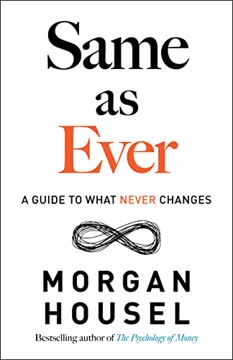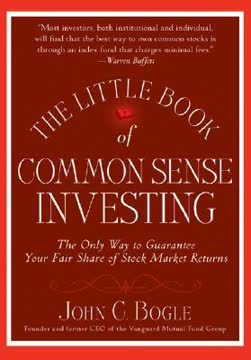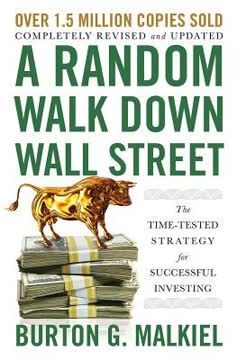Key Takeaways
1. Simplicity is the Master Key to Investing Success
“Simplicity is the master key to financial success.”
Complexity is costly. The financial industry often promotes complex strategies, but simplicity is the key to long-term success. Overly complicated portfolios with numerous funds and individual stocks are difficult to manage, track, and rebalance, often leading to higher costs and lower returns.
The power of "less is more." A simple approach, like the Three-Fund Portfolio, reduces the risk of errors, minimizes maintenance, and frees up time and mental energy. It's easier to understand, implement, and stick with a simple plan, which is crucial for long-term success.
- Fewer funds mean less overlap, lower costs, and easier rebalancing.
- Simplicity reduces stress and allows you to focus on other important aspects of life.
- A simple plan is easier for caregivers and heirs to manage.
Simplicity is not simplistic. While the Three-Fund Portfolio is simple, it's not simplistic. It's based on sound financial principles and academic research, providing a robust and efficient way to invest.
2. Low Costs are the Only Reliable Predictor of Future Returns
“The expense ratio is the only reliable predictor of future mutual fund performance.”
Costs erode returns. High fees and expenses significantly reduce your investment returns over time. Every dollar you save in fees goes directly to your bottom line. The cumulative impact of fees over an investment lifetime can be huge.
- Even seemingly small fees can compound into substantial losses over time.
- Hidden costs, like turnover costs, can be even more damaging than explicit expense ratios.
- Active management fees are often much higher than index fund fees.
Index funds are cost-effective. Total market index funds have extremely low expense ratios and turnover rates, making them a cost-effective way to invest. They also avoid many hidden costs associated with active management.
- Vanguard's expense ratios are among the lowest in the industry.
- Low turnover means lower transaction costs and fewer taxable events.
- Index funds are designed to operate at cost, returning all profits to investors.
Focus on what you can control. While you can't control market returns, you can control your investment costs. Choosing low-cost index funds is one of the most important steps you can take to maximize your long-term wealth.
3. Diversification is the Only Free Lunch in Investing
“If there is one thing about investing on which all authorities agree, it is the benefit of diversification, often called ‘the only free lunch in investing.’”
Reduce risk through diversification. Diversification is the practice of spreading your investments across different asset classes, sectors, and geographies to reduce risk. By not putting all your eggs in one basket, you can minimize the impact of any single investment performing poorly.
- Diversification reduces the volatility of your portfolio.
- It protects you from the risk of individual stock or sector collapses.
- It ensures that you always have some investments performing well.
The Three-Fund Portfolio is highly diversified. The Three-Fund Portfolio provides broad diversification by investing in thousands of stocks and bonds across the U.S. and international markets. This level of diversification is difficult to achieve with individual stocks or actively managed funds.
- It includes large-cap, mid-cap, and small-cap stocks.
- It includes both developed and emerging market stocks.
- It includes a wide range of high-quality bonds.
Diversification is not a guarantee of profit. While diversification reduces risk, it doesn't guarantee profits. However, it does increase your chances of achieving your long-term investment goals.
4. Index Funds Guarantee Your Fair Share of Market Returns
“Index funds are designed simply to assure you that you will earn your fair share of the returns delivered in each segment of The Three-Fund Portfolio—or any other indexing strategy that meets your needs.”
Own the market. Index funds are designed to track the performance of a specific market index, such as the S&P 500 or the total stock market. By investing in an index fund, you own a small piece of every company in that index.
- You capture the average return of the market.
- You avoid the risk of underperforming the market due to poor stock picking.
- You eliminate the need to try to beat the market.
Active management is a zero-sum game. For every investor who beats the market, another investor must underperform. The average actively managed portfolio will, by definition, underperform the average index fund portfolio, net of costs.
- Most active managers fail to beat their benchmark index over the long term.
- The odds of consistently picking winning stocks or funds are very low.
- The costs of active management erode returns.
Index funds are a simple and efficient way to invest. They provide broad diversification, low costs, and a guaranteed share of market returns. They are the most reliable way to achieve your long-term investment goals.
5. Avoid the Temptation of Market Timing and Stock Picking
“After nearly 50 years in this business, I do not know of anybody who has done market timing successfully and consistently. I don’t even know anybody who knows anybody who has done it successfully and consistently.”
Market timing is a fool's errand. Trying to predict market highs and lows is a futile exercise. No one can consistently time the market, not even professional investors.
- Market timing requires predicting both when to buy and when to sell.
- Missing just a few of the best days in the market can significantly reduce your returns.
- Market timing often leads to buying high and selling low.
Stock picking is risky. Trying to pick individual stocks that will outperform the market is also a risky proposition. Most investors, including professionals, fail to beat the market over the long term.
- Individual stocks can plunge to zero.
- It's difficult to compete with professional investors who have access to more information and resources.
- Stock picking often leads to emotional decisions and poor results.
Focus on what you can control. Instead of trying to time the market or pick winning stocks, focus on building a diversified portfolio of low-cost index funds and sticking to your plan.
6. Stay the Course: Consistency Trumps All
“No matter what happens, stick to your program. I’ve said, ‘Stay the course’ a thousand times, and I meant it every time. It’s the most important single piece of investment wisdom I can give to you.”
Discipline is key. The most important factor in long-term investment success is discipline. It's crucial to stick to your investment plan, even when the market is volatile.
- Avoid making emotional decisions based on market fluctuations.
- Don't try to time the market or chase hot investments.
- Rebalance your portfolio regularly to maintain your desired asset allocation.
Bear markets are inevitable. The stock market will experience periods of decline. These periods can be scary, but they are a normal part of the investment cycle.
- Don't panic and sell your stocks during a bear market.
- Use bear markets as an opportunity to buy low.
- Remember that the market has always recovered from past declines.
Long-term perspective. Investing is a long-term game. Don't focus on short-term fluctuations. Focus on building a diversified portfolio and sticking to your plan.
7. Asset Allocation is Your Most Important Decision
“With the exception of the amount you are saving and investing, your asset allocation (i.e., your stock/bond ratio) determines your expected return and expected risk.”
Stock/bond ratio is crucial. Your asset allocation, or the mix of stocks and bonds in your portfolio, is the most important factor in determining your expected return and risk.
- Stocks offer higher potential returns but also higher risk.
- Bonds offer lower potential returns but also lower risk.
- Your asset allocation should be based on your risk tolerance, time horizon, and financial goals.
Age in bonds is a good starting point. A common rule of thumb is to hold a percentage of bonds equal to your age. However, this is just a starting point.
- Younger investors with a longer time horizon can afford to take more risk and hold a higher percentage of stocks.
- Older investors with a shorter time horizon should hold a higher percentage of bonds.
- Your risk tolerance is also a key factor in determining your asset allocation.
Rebalance regularly. Over time, your asset allocation will drift due to market fluctuations. It's important to rebalance your portfolio regularly to maintain your desired stock/bond ratio.
8. Tax Efficiency Maximizes Your Long-Term Wealth
“Investors should never forget that it’s the after-tax returns that count.”
Taxes erode returns. Taxes can significantly reduce your investment returns over time. It's important to invest in a tax-efficient manner to maximize your long-term wealth.
- Capital gains taxes can reduce your profits when you sell investments.
- Dividend taxes can reduce your income from investments.
- High turnover in mutual funds can trigger taxable events.
Index funds are tax-efficient. Total market index funds are among the most tax-efficient investments. They have low turnover, which minimizes taxable events.
- They are eligible for lower tax rates on qualified dividends.
- They are often more tax-efficient than actively managed funds.
- They are ideal for taxable accounts.
Use tax-advantaged accounts. Maximize your contributions to tax-advantaged accounts, such as 401(k)s and IRAs, to reduce your tax burden.
- Traditional IRAs offer tax deductions on contributions.
- Roth IRAs offer tax-free withdrawals in retirement.
- Place tax-inefficient investments, like bonds, in tax-advantaged accounts.
9. The Three-Fund Portfolio is All You Really Need
“By owning just three low-cost total market index funds (Total U.S. Equity, Total U.S. Bond, and Total International Equity), investors have historically outperformed the vast majority of mutual funds over time.”
Three funds are sufficient. The Three-Fund Portfolio is a simple and effective way to build a diversified portfolio. It consists of three low-cost total market index funds:
- A U.S. Total Stock Market Index Fund
- A U.S. Total Bond Market Index Fund
- A Total International Stock Market Index Fund
It's easy to manage. The Three-Fund Portfolio is easy to understand, implement, and maintain. It requires minimal time and effort.
- It eliminates the need to pick individual stocks or funds.
- It reduces the risk of errors and emotional decisions.
- It's easy to rebalance and adjust as needed.
It's highly effective. The Three-Fund Portfolio has historically outperformed the vast majority of actively managed funds. It provides broad diversification, low costs, and a guaranteed share of market returns.
- It's a proven strategy for long-term investment success.
- It's suitable for investors of all ages and risk tolerances.
- It's a simple and efficient way to achieve your financial goals.
Last updated:
FAQ
What's "The Bogleheads' Guide to the Three-Fund Portfolio" about?
- Simple Investment Strategy: The book by Taylor Larimore explains how a simple portfolio of three total market index funds can outperform most investors with less risk.
- Focus on Index Funds: It emphasizes the use of low-cost index funds to achieve broad market exposure and diversification.
- Investment Philosophy: The book is rooted in the Boglehead investment philosophy, which advocates for simplicity, low costs, and long-term investing.
- Educational Resource: It serves as a guide for both novice and experienced investors looking to streamline their investment strategy.
Why should I read "The Bogleheads' Guide to the Three-Fund Portfolio"?
- Proven Strategy: The book presents a strategy that has historically outperformed most actively managed funds.
- Simplicity and Efficiency: It offers a straightforward approach to investing that reduces complexity and maintenance.
- Expert Endorsements: The strategy is endorsed by financial experts and is based on the principles of John C. Bogle, the founder of Vanguard.
- Financial Literacy: Reading the book can enhance your understanding of investment principles and improve your financial literacy.
What are the key takeaways of "The Bogleheads' Guide to the Three-Fund Portfolio"?
- Three-Fund Portfolio: The core strategy involves investing in three total market index funds: U.S. stocks, international stocks, and U.S. bonds.
- Low Costs Matter: Keeping investment costs low is crucial for maximizing returns over the long term.
- Diversification Benefits: The three-fund approach provides broad diversification, reducing risk and increasing the likelihood of achieving investment goals.
- Stay the Course: The book emphasizes the importance of maintaining your investment strategy through market ups and downs.
What are the best quotes from "The Bogleheads' Guide to the Three-Fund Portfolio" and what do they mean?
- "Simplicity is the master key to financial success." This quote underscores the book's central theme that a simple investment strategy can be more effective than complex ones.
- "Stay the course." This mantra, repeated throughout the book, highlights the importance of sticking to your investment plan despite market volatility.
- "You get to keep exactly what you don’t pay for." This emphasizes the impact of low costs on investment returns, a core principle of the Boglehead philosophy.
- "The majesty of simplicity." This phrase captures the elegance and effectiveness of the three-fund portfolio approach.
How does the Three-Fund Portfolio work?
- Three Funds: The portfolio consists of a U.S. Total Stock Market Index Fund, a Total International Stock Index Fund, and a Total Bond Market Index Fund.
- Diversification: These funds provide exposure to thousands of securities, offering broad diversification across different asset classes and geographies.
- Low Maintenance: The simplicity of the portfolio means it requires minimal management and rebalancing.
- Cost Efficiency: By using low-cost index funds, investors can minimize fees and maximize their net returns.
What is the Boglehead Investment Philosophy?
- Long-Term Focus: The philosophy emphasizes long-term investing rather than short-term speculation.
- Cost Awareness: It stresses the importance of keeping investment costs low to enhance returns.
- Diversification: The philosophy advocates for broad diversification to reduce risk.
- Simplicity and Discipline: Investors are encouraged to maintain a simple investment strategy and stay disciplined through market fluctuations.
Why are low-cost index funds recommended in the book?
- Cost Efficiency: Index funds typically have lower expense ratios compared to actively managed funds, which can significantly impact long-term returns.
- Market Performance: Index funds aim to match the performance of the market, which historically outperforms most actively managed funds.
- Reduced Risk: By investing in a broad market index, investors reduce the risk associated with individual stock selection.
- Simplicity: Index funds simplify the investment process, making it easier for investors to manage their portfolios.
What are the benefits of the Three-Fund Portfolio?
- Broad Diversification: The portfolio provides exposure to a wide range of asset classes and geographies, reducing risk.
- Simplicity: With only three funds, the portfolio is easy to manage and rebalance.
- Cost Savings: The use of low-cost index funds minimizes fees, enhancing net returns.
- Consistent Performance: The portfolio is designed to deliver consistent, market-matching returns over the long term.
How does the book address market volatility?
- Stay the Course: The book advises investors to maintain their investment strategy during market ups and downs.
- Rebalancing: It suggests rebalancing the portfolio periodically to maintain the desired asset allocation.
- Long-Term Perspective: Investors are encouraged to focus on long-term goals rather than short-term market fluctuations.
- Emotional Discipline: The book emphasizes the importance of avoiding emotional reactions to market changes.
What role does asset allocation play in the Three-Fund Portfolio?
- Risk Management: Asset allocation determines the balance between stocks and bonds, which affects the portfolio's risk and return profile.
- Customization: Investors can adjust the allocation based on their risk tolerance, investment goals, and time horizon.
- Rebalancing Needs: The book discusses the importance of rebalancing to maintain the desired asset allocation over time.
- Impact on Returns: The allocation between asset classes is a key determinant of the portfolio's overall performance.
How does the book suggest handling taxes in the Three-Fund Portfolio?
- Tax Efficiency: The book highlights the tax efficiency of index funds, which tend to have lower turnover and fewer taxable events.
- Account Types: It discusses the benefits of using tax-advantaged accounts, such as IRAs and 401(k)s, to minimize tax liabilities.
- Tax-Loss Harvesting: The book suggests strategies like tax-loss harvesting to offset gains and reduce taxable income.
- Qualified Dividends: It explains the tax advantages of qualified dividends, which are taxed at a lower rate.
What are the common misconceptions about investing that the book addresses?
- Complexity Equals Success: The book challenges the notion that complex investment strategies are superior, advocating for simplicity instead.
- Market Timing: It dispels the myth that investors can consistently time the market to achieve better returns.
- High Fees Justify Better Performance: The book argues that higher fees do not necessarily lead to better investment outcomes.
- Active Management Superiority: It provides evidence that passive index investing often outperforms active management over the long term.
Review Summary
The Bogleheads' Guide to the Three-Fund Portfolio receives mixed reviews. Many praise its simplicity and effectiveness for beginner investors, highlighting the merits of passive index fund investing. Critics argue it lacks depth, reads like a Vanguard sales pitch, and contains excessive testimonials. Readers appreciate the book's concise explanation of the three-fund strategy but note that much of the information is available online for free. Some find it too US-centric and wish for more comparative analysis. Overall, it's seen as a quick, informative read for those new to the Bogleheads' philosophy.
Similar Books










Download PDF
Download EPUB
.epub digital book format is ideal for reading ebooks on phones, tablets, and e-readers.






